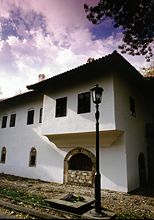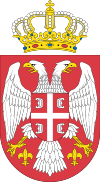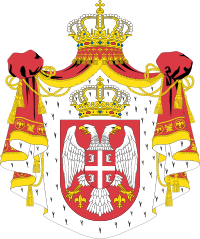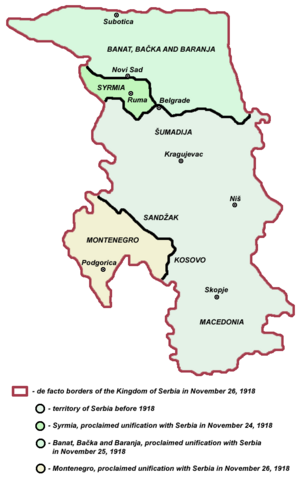Kingdom of Serbia
|
|||||||||||||||||||||||||||||||||||
The Kingdom of Serbia (Serbian: Краљевина Србија, Kraljevina Srbija) was created when Prince Milan Obrenović, ruler of the Principality of Serbia, was crowned King. The Congress of Berlin in 1878 recognized the borders of the Principality of Serbia. The Kingdom of Serbia was the legal predecessor of Yugoslavia which was formed after World War I at the Versailles Peace Conference, 1919.
Contents |
History
It fought several wars, including the Serbo-Bulgarian War of 1885, and the Balkan Wars of 1912–13 (the First Balkan War in 1912–13, and the Second Balkan War in 1913). It won the first Allied victory of World War I in 1914, but in 1915 it was occupied by foreign troops due to a combined invasion by Austro-Hungarian, German, and Bulgarian troops. After the war's end, it united with the Kingdom of Montenegro and the short lived State of Slovenes, Croats and Serbs to form the Kingdom of Serbs, Croats and Slovenes, later known as the Kingdom of Yugoslavia.
Rulers
This article is part of the series on the |
|||
| Medieval Serbia | |||
| Rascia Zeta Doclea Zachlumia, Travunia |
|||
| Serbian Empire | |||
| Moravian Serbia | |||
| Battle of Kosovo | |||
| Serbian Despotate | |||
| Ottoman/Habsburg Serbia | |||
| First Habsburg Serbia | |||
| Second Habsburg Serbia | |||
| Revolutionary Serbia | |||
| Modern Serbia | |||
| Principality of Serbia | |||
| Kingdom of Serbia | |||
| Serbian Campaign (World War I) | |||
| Kingdom of Yugoslavia | |||
| Serbia (1941-1944) | |||
| Republic of Užice | |||
| Socialist Republic of Serbia (as part of SFR Yugoslavia) |
|||
| FR Yugoslavia | |||
| Serbia and Montenegro | |||
| Republic of Serbia
|
|||

Despite its relatively short existence, the Kingdom was ruled by two dynasties: the House of Obrenović and the House of Karađorđević. King Milan Obrenović ruled from 6 March 1882 to 6 March 1889, when he abdicated the throne. He was succeeded by his son, Aleksandar Obrenović, who ruled from 6 March 1889 to 11 June 1903, when he was deposed by a group of officers. The slaughter of the royal couple (the king and Queen Draga) by the Black Hand shocked Europe. This opened the way for the descendants of Karađorđe (Karageorge), regarded by Serbs throughout the Balkans as the man who threw off the Turkish yoke, to return to the throne. Petar Karađorđević was initially reluctant to accept the crown, disgusted as he was by the coup d'état. However, he finally did accept and was the Kingdom's sovereign from 15 June 1903 to 1 December 1918, the day that the Kingdom of Serbs, Croats and Slovenes was proclaimed.
Cities


The largest cities in the Kingdom of Serbia were (with population figures from ca. 1910-1912):
- Belgrade - 100,000
- Prizren - 60,000
- Bitola - 54,000
- Skopje - 50,000
- Niš - 25,000
- Veles - 24,000
- Priština - 20,000
- Prilep - 20,000
- Kragujevac - 18,500
- Ohrid - 18,000
- Tetovo - 14,000
- Leskovac - 13,700
- Šabac - 12,800
- Požarevac - 12,000
- Mitrovica - 12,000
- Vranje - 12,000
- Pirot - 10,000
Notes and references
See also
| Part of a series on |
| Serbs |
 |
| By region or country |
| Diaspora |
| Serbia (Kosovo • Vojvodina) Bosnia and Herzegovina Croatia Republic of Macedonia Montenegro Slovenia |
| Local Albania · Greece · Romania |
| Elsewhere in Europe Austria · France · Germany Hungary · Switzerland · United Kingdom |
| North America Canada · United States |
| Oceania Australia · New Zealand |
| South America Argentina · Brazil · Chile |
| By town or city |
| Europe Budapest · Dubrovnik · Istanbul London · Mostar · Osijek Paris · Sarajevo · Szentendre Trieste · Vienna · Zagreb |
| North America Chicago · Los Angeles Toronto |
| Closely-related ethnic groups |
| Serbian Bokelji · Goranci · Shopi Torlaks · Užičans |
| Closely-related nationalities |
| Bosniaks Croats · Macedonians Montenegrins · Yugoslavs |
| Culture |
| Literature · Music · Art Cinema · Epic poetry · Clans Slava · Costume · Religion Kinship · Cuisine · Sport |
| Language and dialects |
| Serbian · Serbo-Croatian Romano-Serbian · Shtokavian Torlakian · Šatrovački · Užičan Church Slavonic (Old) Slavoserbian Differences between standard
Croatian, Serbian and Bosnian |
| History |
| History of Serbia Origins · Rulers |
- History of Serbia
- Kingdom of Montenegro
External links
Maps
|
Yugoslavia (1929–1941; 1945–2003) |
||||||||||
|
Slovenia, Croatia, Bosnia and Herzegovina, Vojvodina, and Boka Kotorska were part of Austria–Hungary |
Kingdom of Serbs, Croats and Slovenes |
Kingdom of Yugoslavia |
Nazi Germany annexed parts of Slovenia |
Democratic Federal Yugoslavia |
Federal People's Republic of Yugoslavia |
Socialist Federal Republic of Yugoslavia |
Slovenia |
|||
|
Independent State of Croatia |
Croatia |
|||||||||
|
Bosnia and Herzegovina |
||||||||||
|
Hungary annexed Bačka, Baranja, Međimurje, and Prekmurje |
Federal Republic of Yugoslavia |
Serbia and Montenegro |
Serbia |
Serbia |
||||||
|
Autonomous Banat (1941–1944) |
Kosovo |
|||||||||
|
Kingdom of Serbia |
Nedić's Serbia (1941–1944) |
|||||||||
|
Albania annexed most of Kosovo, western Macedonia and south-eastern parts of Montenegro |
Montenegro |
|||||||||
|
Kingdom of Montenegro |
Montenegro (occupied by Italy) |
|||||||||
|
Modern Republic of Macedonia was part of Kingdom of Serbia |
Bulgaria annexed most of modern Republic of Macedonia and south-eastern parts of Serbia |
Republic of Macedonia |
||||||||
sr Cyrillic:Краљевина Србија
sr Latinica: Kraljevina Srbija


